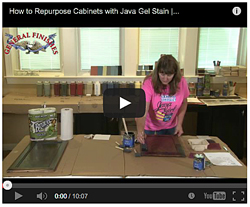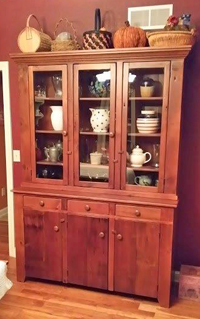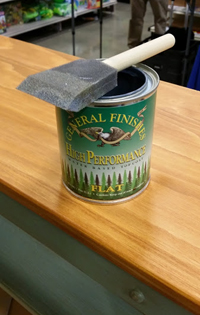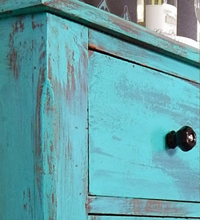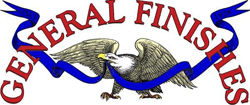
For more than 80 years, General Finishes has been helping woodworkers solve a perplexing conundrum: What is the best finish for my project? Trouble is, there is no single answer to that question. Tom Monahan at General Finishes attests personally to that fact. He’s been a professional finisher for three decades and has worked at General Finishes for 20 of those years.
“One myth about finishing is that there is a perfect finish. I think it’s important to use a wide variety of finishes, whether it’s oils, waxes, varnishes, shellac, lacquers, polys or water-based finishes. Find one that performs to your liking and depth of your finish knowledge,” Monahan says.
While the reality of choosing a suitable finish for your project requires some thought and experimentation, General Finishes has been committed to educating both consumer and professional woodworkers to help make the finishing process easier since its inception. In fact, the company got its start in the finishes industry by developing a simple finishing regimen that trade school students could use to complete their woodworking and cabinetry projects. You might recall it or even have used it prior to the late 1980s. It was known as “The Original 1-2-3 Wipe On Finish.” Step one was to apply a penetrating sealer, called Seal-A-Cell, to prepare the wood for topcoating. Step two — Varn-O-Wax — followed the sealing step, and step three involved applying a product called Royal Finish to complete the process. It was a recipe that found success for woodworkers for some 60 years. During that time, the company added Arm-R-Seal, an oil and urethane topcoat, to the finishing trio for added durability and easy of application.
“We still manufacture and sell Seal-A-Cell Clear and Arm-R-Seal today,” Monahan says.
In addition to those heirloom products, General Finishes’s product line is has grown extensively through the years. The company offers oil-based wood stains, sealers and topcoats, plus a full range of water-based stains, dyes, milk paints, sealers, glazes and topcoats. And, the water-based side of the business continues to build as environmental legislation becomes more restrictive about pollution standards.General Finishes entered the water-based market in 1992. Today, water-based finishes comprise 75 percent of the company’s sales and production, Monahan reports.
“We focus our research on the water-based side of the market because that’s where the growth is. Our main goal is to lower VOCs (volatile organic compounds) and solvent content. The new generation of raw materials is making it easier to produce a greener products while also improving overall performance to the consumer.”
Water-based finishes, which are easy to use and almost odor-free, are good alternatives to oil-based polyurethane. Traditional poly is notoriously slow drying with a strong solvent smell. Still, Monahan says “many woodworkers are reluctant to ever try anything else.” That’s why in 2008, General Finishes introduced Enduro Var: it’s what might be considered a happy medium to oil-based poly. The product is an oil-modified alkyd varnish in a water-based formula. This hybrid dries fast and cleans up with water, yet it imparts the desirable amber tone of an oil-based varnish to give the finish a warm glow. Enduro Var has found a niche with woodworkers as an excellent topcoat for dark woods such cherry, walnut and mahogany, Monahan says.
In addition to Enduro Var, GF gel stains have also been very successful with the oil-based woodworking crowd. Their thick formulation makes them easy to apply to vertical surfaces without creating runs and drips, and their penetration characteristics make them a good solution for blotch-prone woods like pine, where an oil-based pigment stain could produce uneven coloration.
Several years ago, General Finishes’ coffee-colored Java gel stain became a refinishing sensation for DIYers, particularly as a contemporary color change for kitchen cabinetry. Thanks to the Internet, bloggers and DIYers began to post photos of their cabinet remodeling projects to social media outlets such as Facebook and Pinterest. Java stain continues to be a strong seller to this market now.
For those woodworkers who have ventured into the arena of water-based finishes, Monahan reports that General Finishes’ water-based wood stains and dyes are very popular. So is the company’s High Performance finish: it’s a polyacrylic blend that, according to General Finishes’ estimation, is the hardest, most durable consumer polyurethane topcoat on the market. It also contains a UV stabilizer to prevent the cured finish from breaking down in sunlight, while also protecting underlying stains from fading.
One of the most surprising new trends in finishing revolves around today’s “upcycling” craze. It’s a trend where do-it-yourselfers buy older furniture from thrift stores and antique markets, modify them in some fashion for re-use and then finish them with milk paint to give their projects an updated, contemporary look. GF’s milk paints come in 28 mixable colors and provide the old-fashioned look of traditional milk or chalk paint in a formula that contains a heavy mineral base but no milk. It’s UV resistant and suitable for indoor or outdoor projects. Whether brush-applied or sprayed, milk paint can be lightened, distressed, glazed or antiqued, and it cleans up with soap and water. Repurposing furniture with milk paint “has helped us reach a whole new customer base,” Monahan says.
Still, whether a project is scratch-built from a pile of lumber or a flea market find on its way to a second life, woodworkers and upcyclers alike may feel intimidated about ruining their hard work with a poorly applied finish. That’s why General Finishes provides several resources to help ease the decision-making and application process. The company’s website offers an email exchange where customers can ask questions and receive prompt responses. “We have a knowledgeable staff that can answer almost any finishing question,” Monahan assures. Or for educational tutorials, click on the “Finishing Design Center” option on the website for written instructions or the “Videos” option to open a library of more than 30 finishing topics that feature General Finishes products.
Finishing is really a lifelong learning process, Monahan believes. “I have always said the best finish I have done is the last one I just completed.” But with more consumer-friendly options and easy-to-find resources to help you along, finishing doesn’t have to be as daunting anymore. “And, the more you experiment, the more you learn.”

